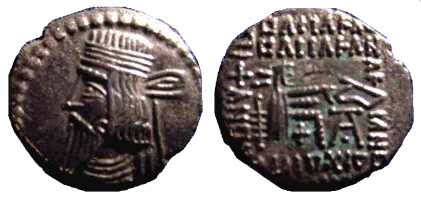| 51 AD - 78 AD |
Ολόγασος Α'
| Drachm / Δραχμή AR |
SHH 1574 |
 |
| Parameter Obverse Reverse Notes Reference |
3.36 g 17.5-19.5 mm
12:00 o'clock EF Diademed and cuirassed bust left with long beard; circular border of dots. Archer enthroned right, holding bow beneath which ΑΓΤ monogram; seven line legend with numerus blunders. ? Copenhagen 192/195; Sear Greek Imperial 5801 |
|
Vologases
I (51 - 77 AD)
http://96.1911encyclopedia.org/V/VO/VOLOGAESES.htm
VOLOGAESES I., son of Vonones II. by a Greek concubine (Tac. Ann. xii. 44), succeeded his father in A.D. 51 (Tac. Ann. xii. 14; cf. Joseph. Ant. xx. 3, 4). He gave the kingdom of Media Atropatene to his brother Pacorus, and occupied Armenia for another brother, Tiridates (Tac. Ann. xii. 50, xv. 2; Joseph. Ant. xx. 3, 4). This led to a long war with Rome (54-63), which was ably conducted by the Roman general Corbulo. The power of Vologaeses was weakened by an attack of the Dahan and Sacan nomads, a rebellion of the Hyrcanians, and the usurpation of VardanesII. (Tac. Ann. xiii. 7, 37; xiv. 25; xv. i; cf. Joseph. Ant. xx. 4, 2, where he is prevented from attacking the vassal king of Adiabene by an invasion of the eastern nomads). At last a peace was concluded, by which Tiridates was acknowledged as king of Armenia, but had to become a vassal of the Romans; he went to Rome, where Nero gave him back the diadem (Tac. Ann. xv. iff.; Dio Cass. Ixii. 19 ff., Ixiii. i ff.); from that time an Arsacid dynasty ruled in Armenia under Roman supremacy. Vologaeses was satisfied with thisresult, and honoured the memory of Nero (Suet. Nero, 57), though he stood in good relations with Vespasian also, to whom he offered an army of 40,000 archers in the war against Vitellius (Tac. Hist. iv. 51; Suet, Vespas. 6; cf. Joseph. Ant. vii. 5, 2, 7, 3; Dio Cass. Ixvi. n). Soon afterwards the Alani, a great nomadic tribe beyond the Caucasus, invaded Media and Armenia (Joseph. Bell. vii. 7, 4); Vologaeses applied in vain for help to Vespasian (Dio Cass. Ixvi. n; Suet. Domitian, 2). It appears that the Persian losses in the east also could not be repaired; Hyrcania remained an independent kingdom (Joseph. Bell. vii. 7,4; Aurel. Vict. Epit. 15, 4). Vologaeses I. died about A.D. 77. His reign is marked by a decided reaction against Hellenism; he built Vologesocerta (Balashkert) in the neighbourhood of Ctesiphon with the intention of drawing to this new town the inhabitants.of the Greek city Seleucia (Plin. vi. 122). Another town founded by him is Vologesias on a canal of the Euphrates, south of Babylon (near Hira; cf. Noldeke in Zeitschnjt der deutschcn-morgenl. Gesellschaft, xxviii. 93 ff.). On some of his coins the initials of his name appear in Aramaic letters. |